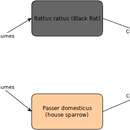Rats, Mice, Hamsters, Voles, Lemmings, and Gerbils
provided by EOL authors
This family of 301 Recent genera and 1,336 species is by far the largest mammalian family. With the exception of certain arctic islands, parts of the West Indies, New Zealand, many oceanic islands, and Antarctica, its natural range extends worldwide. Introduction through human agency has led to the establishment of several species of murids on many of the islands where the family originally was absent. There long has been controversy regarding which groups are included in this family and how these groups are interrelated. The Muridae here are considered to comprise the 16 subfamilies listed below. However, many authorities have followed Simpson (1945) in giving familial status to the Sigmodontinae (with the name Cricetidae), the Spalacinae, the Platacanthomyinae, the Rhizomyinae, and the Murinae. Based in part on paleontological evidence, Chaline, Mein, and Petter (1977) went even further and recognized the following as separate families: the Sigmodontinae (with the name Cricetidae and including the Cricetinae, the Spalacinae, the Myospalacinae, the Lophiomyinae, and the Platacanthomyinae as subfamilies), the Nesomyinae (including the Otomyinae as a subfamily), the Rhizomyinae, the Gerbillinae, the Arvicolinae, the Dendromuridae (including the Petromyscinae as a subfamily), the Cricetomyinae, and the Murinae (including the Hydromyinae as a subfamily). The actual sequence used by Chaline, Mein, and Petter (1977) generally has been followed here. However, all of the families have been made parts of a single family, which in accordance with nomenclatural priority is called the Muridae. Although Simpson (1945) separated the Muridae and the Cricetidae, many authorities have considered the differences between the two insufficient to warrant familial distinction. The latter position was taken by Hershkovitz (1962) and E. R. Hall (1981) and is followed here. Once the Cricetidae are made part of the Muridae, it becomes reasonable to do the same with the other families listed by Chaline, Mein, and Petter (1977). This procedure was followed by Carleton and Musser (1984), Corbet and Hill (1991), and Musser and Carleton (in Wilson and Reeder 1993), though with some modification of sequence. Also, Carleton and Musser (1984) and Musser and Carleton (in Wilson and Reeder 1993) considered the subfamily Hydromyinae to be part of the Murinae, whereas Lidicker and Brylski (1987) included the Australian genera Mesembriomys, Conilurus, Leporillus, Zyzomys, Pseudomys, Notomys, Leggadina, and Mastacomys in the Hydromyinae. Corbet and Hill (1991) placed the subfamily Petromyscinae within the Dendromurinae. There remains considerable support for keeping the Rhizomyidae as a separate family (Lekagul and McNeely 1977; Medway 1978).
- license
- cc-by-nc
- copyright
- The John Hopkins University Press
- bibliographic citation
- Nowak, Ronald M. "RODENTIA; MURIDAE." Walker's Mammals of the World. Sixth ed. Vol. II. Baltimore, Maryland: John Hopkins UP, 1999. 1334-1346. Print.
- author
- CJ Kronk (Superraptor)

